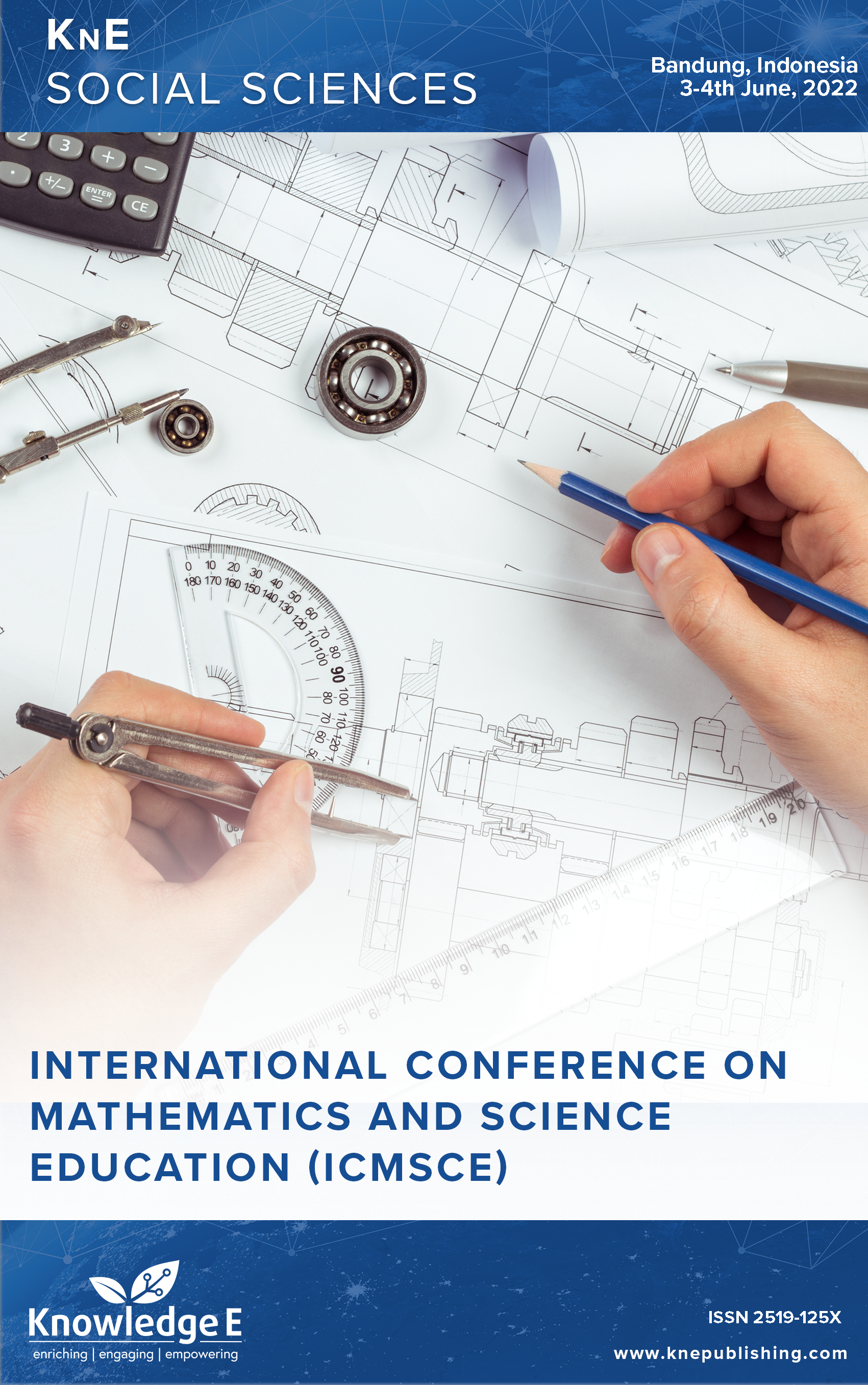Designing a Hypothetical Learning Trajectory Using Prezi Presentation and GeoGebra Application on Flat-Shaped Triangle Geometry Materials
DOI:
https://doi.org/10.18502/kss.v9i13.15943Abstract
Technology plays a crucial role in enhancing the quality of math learning. In addition to adapting to the rapid advancement of ICT, technology serves as a visualization aid for abstract mathematical concepts, facilitating understanding. Prezi presentations and GeoGebra application are technological tools that can be used as a medium for learning math. Prezi Presentation is used as a presentation medium, while GeoGebra functions as a dynamic tool to enhance the understanding of geometry. They both positively impact the development of mathematical thinking, facilitate meaningful learning experiences, and can be used as alternatives in designing a hypothetical learning trajectory for concepts related to triangle types. This study aims to design a Hypothetical Learning Trajectory (HLT) using Prezi presentation and GeoGebra for the material related to triangle types. The HLT tailored to suit the characteristics of students, making it easier to construct independent understanding related to triangle types through the use of dynamic technology such as Prezi and GeoGebra. This study uses a design research approach consisting of three phases: introduction, design experiments, and retrospective analysis. This was carried out solely in the preliminary phase to develop the initial prototype of the HLT focusing on the concept of triangle types. The HLT will be further examined in subsequent research and retrospectively analyzed to develop the Learning Instructional Theory (LIT) as the final product.
Keywords: flat-shaped triangle geometry materials, geogebra application, hypothetical learning trajectory, prezi presentation
References
Jelatu S, Sariyasa S, Ardana IM. Sariyasa, and I. Made Ardana, “Effect of GeoGebraaided REACT strategy on understanding of geometry concepts.,”. Int J Instr. 2018;11(4):325–36. DOI: https://doi.org/10.12973/iji.2018.11421a
Abdullah AH, Zakaria E. “The effects of Van Hiele’s phases of learning geometry on students’ degree of acquisition of Van Hiele Levels,” Procedia - Social and Behavioral Sciences. vol. 102, no. Ifee. 2013;2012:251–66. DOI: https://doi.org/10.1016/j.sbspro.2013.10.740
Hwang WY, Hu SS. Analysis of peer learning behaviors using multiple representations in virtual reality and their impacts on geometry problem-solving. Comput Educ. 2013;62(March):308–19. DOI: https://doi.org/10.1016/j.compedu.2012.10.005
Faruk Tutkun O, Ozturk B. The effect of GeoGebra mathematical software to the academic success and the level of Van Hiele geometrical thinking. Int J Acad Res. 2013;5(4):22–8. DOI: https://doi.org/10.7813/2075-4124.2013/5-4/B.3
Amaliyah AR R, Mahmud N; R.A. AR and N. Mahmud. Analisis kemampuan representasi matematis dalam pemecahan masalah geometri serta faktor-faktor yang mempengaruhinya [ Jurnal Review Pembelajaran Matematika]. JRPM. 2018;3(2):146– 60. DOI: https://doi.org/10.15642/jrpm.2018.3.2.146-160
Muslimin M, Sunardi S. Analisis kemampuan penalaran matematika siswa SMA pada materi geometri ruang. Kreano, Jurnal Matematika Kreatif-Inovatif. 2019;10(2):171–8. DOI: https://doi.org/10.15294/kreano.v10i2.18323
Hikmawati NN, Nurcahyono NA, Balkist PS. Kemampuan Komunikasi matematis siswa dalam menyelesaikan soal geometri kubus dan balok. Prisma. 2019;8(1):68. DOI: https://doi.org/10.35194/jp.v8i1.648
N. Nuraini and Z. Abidin, “Kesulitan guru dalam mengimplementasikan pembelajaran tematik terintegratif di sekolah dasar.,” Premiere Educandum : Jurnal Pendidikan Dasar dan Pembelajaran. vol. 10, no. 1, p. 49, 2020. https://doi.org/10.25273/pe.v10i1.5987. DOI: https://doi.org/10.25273/pe.v10i1.5987
In’am A, Hajar S. Learning geometry through discovery learning using a scientific approach. Int J Instr. 2017;10(1):55–70. DOI: https://doi.org/10.12973/iji.2017.1014a
Gargrish S, Mantri A, Kaur DP. “Augmented reality-based learning environment to enhance teaching-learning experience in geometry education.,” Procedia Computer Science. vol. 172, no. 2019, pp. 1039–1046, 2020. https://doi.org/10.1016/j.procs.2020.05.152. DOI: https://doi.org/10.1016/j.procs.2020.05.152
Saha RA, Ayub AF, Tarmizi RA. The effects of GeoGebra on mathematics achievement: enlightening coordinate geometry learning. Procedia Soc Behav Sci. 2010;8(5):686–93. DOI: https://doi.org/10.1016/j.sbspro.2010.12.095
Hillmayr D, Ziernwald L, Reinhold F, Hofer SI, Reiss KM. “The potential of digital tools to enhance mathematics and science learning in secondary schools: A contextspecific meta-analysis.,” Computers and Education. vol. 153, no. September 2018, p. 103897, 2020. DOI: https://doi.org/10.1016/j.compedu.2020.103897
Ghavifekr S, Rosdy WA. Teaching and learning with technology: effectiveness of ICT integration in schools. International Journal of Research in Education and Science. 2015;1(2):175–91. DOI: https://doi.org/10.21890/ijres.23596
Turgut İG, Turgut S. “The effects of visualization on mathematics achievement in reference to thesis studies conducted in Turkey: A meta-analysis.,” Universal Journal of Educational Research. vol. 6, no. 5, pp. 1094–1106, 2018. DOI: https://doi.org/10.13189/ujer.2018.060531
Turgut M, Smith JL, Andrews-Larson C. Symbolizing lines and planes as linear combinations in a dynamic geometry environment. J Math Behav. 2022;66(March):100948. DOI: https://doi.org/10.1016/j.jmathb.2022.100948
van den Akker J, Bannan B, Nieven N, Plomp T. “An introduction to Educational Design Research.,” Presented at the (2010).
Risdiyanti I, Prahmana RC. Ethnomathematics (Teori dan Implementasinya : suatu pengantar). Yogyakarta: UAD Press; 2020.
Prahmana RC. Design research (Teori dan Implementasinya: Suatu Pengantar). Depok: Raja Grafindo Persada; 2018.
Özen D, Köse NY. Investigating pre-service mathematics teachers’ geometric problem solving process in dynamic geometry environment. Turkish Online Journal of Qualitative Inquiry. 2013;4(3):61–74.
Hutkemri and E. Zakaria. The effect of geogebra on students’conceptualand procedural knowledge of function. Indian J Sci Technol. 2012;5(12):3802–8.
Zulnaidi H, Zamri SN. The effectiveness of the geogebra software: the intermediary role of procedural knowledge on students’ conceptual knowledge and their achievement in mathematics. Eurasia J Math Sci Technol Educ. 2017;13(6):2155–80. DOI: https://doi.org/10.12973/eurasia.2017.01219a
Richardson JC. Book Review: A practical guide to problem-based learning online. Interdiscip J Probl Based Learn. 2009;3(1):90–2. DOI: https://doi.org/10.7771/1541-5015.1089
Azizul SM, Din R. Teaching and learning geometry using GeoGebra sostware via MOOC. Journal of Personalized Learning. 2016;2(1):40–51.

